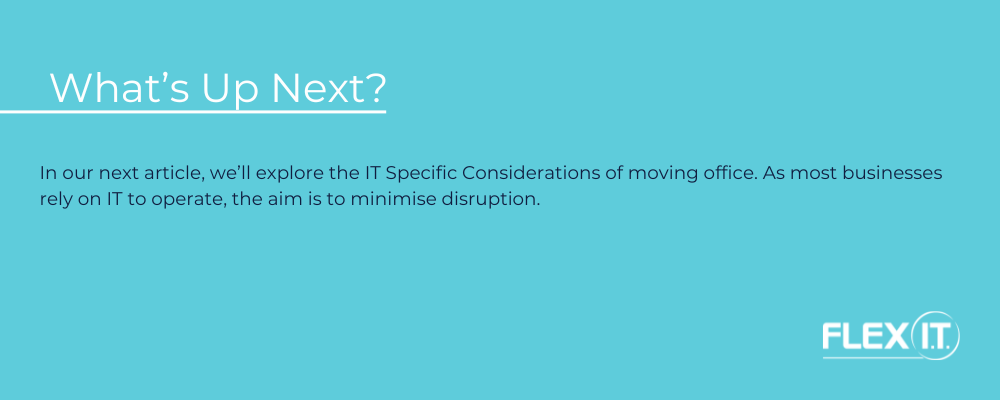So now that you’ve thought about Home and Remote team members you can start preparing for the move and the sooner the better, as there is always more to do than you can imagine. The closer you get to the move date, the harder it is to keep pace with everything. This is where essential things can get overlooked and cause problems. To help save you from unnecessary stress, we break down the things you need to get in line, ahead of time.
Before you Move
1. Itemise Everything that Needs to Move
An office serves multiple purposes, so it’s probably full of stuff. Desks, chairs and computer equipment are just the beginning. There will be furniture, files and books, servers, bins, the fridge and coffee machine, and lots more.
It’s never too early to start itemising everything you have and organise it into lists including:
- What will move with you
- What you will donate/sell
- What you will get rid of
For the stuff you no longer need, put an action and date for who, when and where it needs to go. Wherever possible donate, sell or recycle to avoid being wasteful. The more time you allow, the easier it is to avoid items ending up in landfill.
This ReThink Office Furniture article lists 5 places that accept and distribute donations.
2. Make a Floor Plan of your New Office
There’s a shortcut option here - ask the estate agent who found your new office whether they have a floor plan they can provide you with. Whether they supply it or you create it, you can start mapping out what goes where. It can also be helpful to arrange a visit to measure and fully understand the space.
Here are some essential points to include:
- Add people to the floor plan – where will each employee work and what systems/equipment do they need access to?
- Where do you need to position network points? - consider what is currently in place and what may be required to future-proof the business.
- Are there sufficient cabling routes, power outlets and wireless access points? – your IT team will be able to help or recommend a cabling company if changes need to be made.
- Where will servers and network equipment be located? Is there a designated place in the plan?
- How will communal areas be laid out? – optimise space and functionality by trying out different options for the position of furniture and fittings in meeting rooms, kitchens and staff rooms.
In our experience, a colour-coded plan to differentiate responsibilities, departments or types of equipment can be beneficial. This allows individuals to focus on the specifics that they need to manage.
The benefits of a floor plan are:
- Checking that all equipment will fit
- Reassuring all employees that they will have access to what they need
- Addressing gaps in advance of move day
- Answering any unknowns
- Explaining to your removal team where everything will go in the new office
3. Keep your Team Informed
It is vital to keep your team informed at every stage of the plan.
The Moving Office Employment Law Checklist summarises all the legal implications surrounding your obligations to employees. It’s worth reading this before announcing your office move to staff.
Be sure to understand your obligations and check you’re not in breach of employee contracts by moving office. If you’ve included a mobility clause in the contract, providing reasonable notice is all that is required to change the employee’s place of work. In some cases, you may be obliged to offer a redundancy package if an employee refuses to relocate to your new office.
You might wish to direct your team to this information:
https://www.gov.uk/employer-relocation-your-rights
Managing Change
Change can be met with anxiety and if you fail to regularly communicate, uncertainty and concerns will grow. So, follow this advice to deliver the news clearly and effectively:
- Be open and honest. If you try to hide challenges, they will pick up on it and it can fuel rumours.
- Invite questions and welcome them – preparing answers to ‘FAQs’ ahead of time will ensure you have clear responses to points raised. If you don’t know the answer, explain that you will find out and get back to them, then do it!
- Keep things simple - don’t overcomplicate the news with corporate jargon. It’s a change of location for a logical reason, so share the news as it is.
- Explain the stage the plans are at, from researching potential locations to the final days. Let the team know what to expect and how you would like them to get involved. Will they have specific responsibilities in the process?
- Regularly thank the team for their understanding and involvement. Reiterate the benefits of the move and the positive outlooks for the business and their roles within it.
4. Plan your Move Marketing
There are two things to consider when it comes to marketing your office move:
- Communicating the fact that you’ve moved to allow the business to continue as normal
- Celebrate the fact that you’ve moved
Communicating your Move - The first step is listing who needs to know that you’re moving and how best to inform them. We recommend several forms of communication to clients/customers, partners and suppliers to prepare and reassure them. Then, a confirmation email and potentially an invitation to visit once you are in.
Also, update your website, email signatures, invoices, Google My Business and any listing you have on external sites, such as industry directories.
Celebrating Your Move - Once you’ve moved, prepare messages that celebrate the move, with an emphasis on the benefits to customers. These can be shared in your company newsletter, email marketing and on social media.
Regardless of why you’re moving, it can and should be an exciting time for your business. So, use it as a chance to engage with local groups and business news outlets to raise your brand profile. Share where you’ve been and where you’re going!
How about a ‘relocation offer’ for loyal customers and/or a ‘new customer discount’ for those living in the local postcode? This can engage interest and involve others in your celebrations.
5. Security & Insurance
Before moving, you want to check that on-premises systems are secure. This is all about protecting your assets, company data and intellectual property before, during or after the move.
In addition, check your insurance. Does it cover relocation and if not, can you add this to the policy? Considering the changes you are making as part of the move, is the insurance still sufficient for the new office?
6. Book a Removals Company
Moving office is every bit as disruptive as moving house and the consequences of not doing it efficiently can be greater. It requires expertise in packing, handling and loading. Equally, you need a team that’s equipped with suitable vehicles and has experience in coordinating a move. As such, a professional removal company will be well worth the investment.
We recommend meeting with at least three suitable removal companies. Invite them to your current office and, if possible, the new one, so they can provide an accurate estimate of timeframes and cost. Then select your preferred option.
7. Plan your Office Design
The new office layout is about more than where to position the furniture. Creating a pleasant place to work can boost productivity and retention of staff. For this reason, it’s well worth building some time into your schedule to design your new office.
You could hire an interior design firm that will prepare a solution that caters to your requirements. It may include ideas for storage, optimising light and other factors that you wouldn’t have considered. It’s another cost, but could be a worthwhile investment.
Alternatively, plan and decorate the office yourself. For a small or simple layout, this can work, just consider the following:
- Atmosphere – Many companies have embraced the open-plan philosophy, citing its support of collaboration. Whilst it has its merits, an open-plan office won’t be for everyone. If your team need to get on with quiet, focused work, don’t forget to provide quiet spaces.
- Creativity – Creativity isn’t all about throwing artwork on the wall, it can be as simple as creating different ‘zones’ within your office. The main working ‘zone’ will cater for day-to-day business activities. Then, comfortable sofas in a different area can be used for client meetings, employee discussions or breaks. Screened areas can be effective for soundproofing quiet work areas.
- Access – Take great care to make everything in the office accessible to all members of the current team and future hires. This includes workstations, breakout facilities and building access.
- Biophilic design – There is documented evidence that a connection with nature creates a calm and productive workspace. This can be achieved by using nature-inspired paint colours, houseplants and natural materials like cork and wood in your interior design.
- Lighting – you need more than ambient lighting in a work environment. Firstly, maximise natural light and then, incorporate task lighting over primary work areas will help employees have a clear view.
- Ergonomics – maintaining employee health is dependent on ensuring the correct position of office chairs, desks and equipment. Wherever possible, your interior design should be adjustable to help employees operate without putting unnecessary strain on the body.
- Temperature – are there spaces that need to be kept cool or warm? Is there sufficient ventilation, air conditioning and heating to achieve a comfortable ambient temperature?
8. Order your Office Furniture
Lead-in times for furniture can be longer than you’d expect, so order your furniture as soon as you can. Speak to suppliers about delivery slots that correspond with your move plans. You may need items of furniture in advance of the move or it could be easier to have it arrive at the new office.
9. Hire Office Cleaners
Unless this is not a requirement of your lease, you’ll want a cleaning supplier lined up to give your old office a thorough clean. The return of your deposit is normally dependent on the space being ready for the new tenant. Equally, you may want them to undertake a pre-move clean of your new premises.
Invite at least three cleaning firms to view and quote for your cleaning requirements and book your preferred option. It is useful to have a spare set of keys for the cleaning supplier to gain access.
Pre-move Summary
It may seem like a big undertaking, yet completing these tasks will help everything flow smoothly on the day of your office move. Do you find it easier to have one individual overseeing all the actions or to delegate to different team members?
If you are relocating Contact us today to find out how we can assist.

